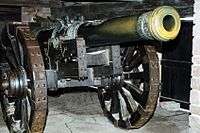Gunpowder artillery in the Song dynasty
| Part of a series on |
| Cannon |
|---|
 |
| History |
| Operation |
| By country |
| By type |
Gunpowder artillery in the Song dynasty included the 'multiple bullets magazine erupters' ('bai zu lian zhu pao'), consisting of a tube of bronze or cast iron that was filled with about 100 lead balls,[1] and the 'flying-cloud thunderclap eruptor' (fei yun pi-li pao), an early cast iron cannon. The use of cannon, and other gunpowder weapons, enabled the Song dynasty to ward off its militant enemies—the Liao, Western Xia, and Jin—until its final collapse under the onslaught of the Mongol forces of Kublai Khan in the late 13th century.
History

Although the destructive effects of gunpowder were described in the earlier Tang dynasty by a Daoist alchemist, the earliest-known existent written formulas for gunpowder come from the Wujing Zongyao text of 1044, which described explosive bombs hurled from catapults.[3] The earliest developments of the gun barrel and the projectile-fire cannon were found in late Song China. The first art depiction of the Chinese 'fire lance' (a combination of a temporary-fire flamethrower and gun) was from a Buddhist mural painting of Dunhuang, dated circa 950.[4] These 'fire-lances' were widespread in use by the early 12th century, featuring hollowed bamboo poles as tubes to fire sand particles (to blind and choke), lead pellets, bits of sharp metal and pottery shards, and finally large gunpowder-propelled arrows and rocket weaponry.[5] Eventually, perishable bamboo was replaced with hollow tubes of cast iron, and so too did the terminology of this new weapon change, from 'fire-spear' ('huo qiang') to 'fire-tube' ('huo tong').[6] This ancestor to the gun was complemented by the ancestor to the cannon, what the Chinese referred to since the 13th century as the 'multiple bullets magazine erupter' ('bai zu lian zhu pao'), a tube of bronze or cast iron that was filled with about 100 lead balls.[1]
The earliest known depiction of a gun is a sculpture from a cave in Sichuan, dating to 1128, that portrays a figure carrying a vase-shaped bombard, firing flames and a cannonball.[7] However, the oldest existent archaeological discovery of a metal barrel handgun is from the Chinese Heilongjiang excavation, dated to 1288.[8] The Chinese also discovered the explosive potential of packing hollowed cannonball shells with gunpowder. Written later by Jiao Yu in his Huolongjing (mid 14th century), this manuscript recorded an earlier Song-era cast iron cannon known as the 'flying-cloud thunderclap eruptor' (fei yun pi-li pao). The manuscript stated that:
The shells are made of cast iron, as large as a bowl and shaped like a ball. Inside they contain half a pound of 'magic' gunpowder. They are sent flying towards the enemy camp from an eruptor; and when they get there a sound like a thunder-clap is heard, and flashes of light appear. If ten of these shells are fired successfully into the enemy camp, the whole place will be set ablaze…[9]
As noted before, the change in terminology for these new weapons during the Song period were gradual. The early Song cannons were at first termed the same way as the Chinese trebuchet catapult. A later Ming dynasty scholar known as Mao Yuanyi would explain this use of terminology and true origins of the cannon in his text of the Wubei Zhi, written in 1628:
The Song people used the turntable trebuchet, the single-pole trebuchet and the squatting-tiger trebuchet. They were all called 'fire trebuchets' because they were used to project fire-weapons like the (fire-)ball, (fire-)falcon, and (fire-)lance. They were the ancestors of the cannon.[10]
References
Citations
- 1 2 Needham, Volume 5, Part 7, 263-364.
- ↑ Needham 1986, p. 266
- ↑ Ebrey, Cambridge Illustrated History of China, 138.
- ↑ Needham, Volume 5, Part 7, 224–225.
- ↑ Needham, Volume 5, Part 7, 220–221.
- ↑ Needham, Volume 5, Part 7, 221.
- ↑ Gwei-Djen, Lu; Joseph Needham; Phan Chi-Hsing (July 1988). "The Oldest Representation of a Bombard". Technology and Culture. Johns Hopkins University Press. 29 (3): 594–605. doi:10.2307/3105275. JSTOR 3105275.
- ↑ Needham, Volume 5, Part 7, 293.
- ↑ Needham, Volume 5, Part 7, 264.
- ↑ Needham, Volume 5, Part 7, 22.
Sources
- Ebrey, Patricia Buckley (1999). The Cambridge Illustrated History of China. Cambridge: Cambridge University Press. ISBN 0-521-43519-6 (hardback); ISBN 0-521-66991-X (paperback).
- Needham, Joseph (1986). Science and Civilisation in China: Volume 5, Chemistry and Chemical Technology, Part 7, Military Technology, the Gunpowder Epic. Cambridge: Cambridge University Press.